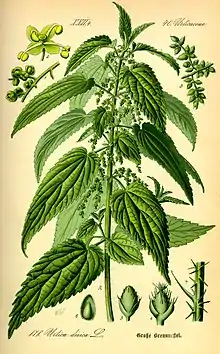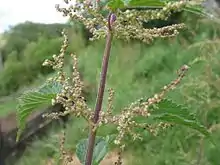Urtica
Urtica is a genus of flowering plants in the family Urticaceae. Many species have stinging hairs and may be called nettles or stinging nettles, although the latter name applies particularly to Urtica dioica.
| Nettle | |
|---|---|
 | |
| Stinging nettle (Urtica dioica)[1] | |
| Scientific classification | |
| Kingdom: | Plantae |
| Clade: | Tracheophytes |
| Clade: | Angiosperms |
| Clade: | Eudicots |
| Clade: | Rosids |
| Order: | Rosales |
| Family: | Urticaceae |
| Tribe: | Urticeae |
| Genus: | Urtica L. |
| Species | |
|
See text | |
Urtica species are food for the caterpillars of numerous Lepidoptera (butterflies and moths), such as the tortrix moth Syricoris lacunana and several Nymphalidae, such as Vanessa atalanta, one of the red admiral butterflies.[2]
Description
Urtica species grow as annuals or perennial herbaceous plants, rarely shrubs. They can reach, depending on the type, location and nutrient status, a height of 10–300 centimetres (3.9–118.1 in). The perennial species have underground rhizomes. The green parts have stinging hairs. Their often quadrangular stems are unbranched or branched, erect, ascending or spreading.
Most leaves and stalks are arranged across opposite sides of the stem. The leaf blades are elliptic, lanceolate, ovate or circular. The leaf blades usually have three to five, rarely up to seven veins. The leaf margin is usually serrate to more or less coarsely toothed. The often-lasting bracts are free or fused to each other. The cystoliths are extended to more or less rounded.
In 1874, while in Collioure (south of France), French botanist Charles Naudin discovered that strong winds during 24 hours made the stinging hairs of Urtica harmless for a whole week.[3]
Species

.jpg.webp)
A large number of species included within the genus in the older literature are now recognized as synonyms of Urtica dioica. Some of these taxa are still recognized as subspecies.[4]
Species in the genus Urtica, and their primary natural ranges, include:
- Urtica andicola Webb
- Urtica angustifolia Fisch. ex Hornem. China, Japan, Korea
- Urtica ardens China
- Urtica aspera Petrie South Island, New Zealand
- Urtica atrichocaulis Himalaya, southwestern China
- Urtica atrovirens western Mediterranean region
- Urtica australis Hook.f. South Island, New Zealand and surrounding subantarctic islands
- Urtica cannabina L., Western Asia from Siberia to Iran
- Urtica chamaedryoides (heartleaf nettle), southeastern North America
- Urtica dioica L. (stinging nettle or bull nettle), Europe, Asia, North America
- Urtica dioica subsp. galeopsifolia Wierzb. ex Opiz (fen nettle or stingless nettle), Europe. (Sometimes treated as a separate species Urtica galeopsifolia.)
- Urtica dubia – illegitimate synonym of U. membranacea
- Urtica ferox G.Forst. (ongaonga or tree nettle), New Zealand
- Urtica fissa China
- Urtica gracilenta (mountain nettle), Arizona, New Mexico, west Texas, northern Mexico
- Urtica hyperborea Himalaya from Pakistan to Bhutan, Mongolia and Tibet, high altitudes
- Urtica incisa Poir (scrub nettle), Australia, New Zealand
- Urtica kioviensis Rogow. eastern Europe
- Urtica laetivirens Maxim. Japan, Northeast China
- Urtica lalibertadensis
- Urtica linearifolia (Hook.f.) Cockayne (creeping or swamp nettle), New Zealand
- Urtica mairei Himalaya, southwestern China, northeastern India, Myanmar
- Urtica massaica Africa
- Urtica membranacea Poir. ex Savigny Mediterranean region, Azores and Madeira
- Urtica morifolia Poir. Macaronesia
- Urtica minutifolia Griseb. Bolivia
- Urtica parviflora Himalaya (lower altitudes)
- Urtica peruviana D.Getltman Perú
- Urtica pseudomagellanica D.Geltman Bolivia
- Urtica pilulifera (Roman nettle), southern Europe
- Urtica platyphylla Wedd. Kamchatka, Sakhalin, Japan
- Urtica procera Mühlenberg (tall nettle), North America
- Urtica pubescens Ledeb. Southwestern Russia east to central Asia
- Urtica rupestris Sicily (endemic)
- Urtica sondenii (Simmons) Avrorin ex Geltman northeastern Europe, northern Asia
- Urtica taiwaniana Taiwan
- Urtica thunbergiana Japan, Taiwan
- Urtica triangularis
- Urtica urens L. (small nettle or annual nettle), Europe, North America
- Urtica urentivelutina
Ecology
Due to the stinging hairs, Urtica species are rarely eaten by herbivores, but rather provide shelter for insects, such as aphids, butterfly larvae, and moths.[5]
Uses
Fabric woven of nettle fiber was found in burial sites dating to the Bronze Age, and in clothing fabric, sailcloth, fishing nets, and paper by indigenous communities.[6] In New Zealand, U. ferox is classified among poisonous plants, most commonly upon skin contact.[7]
Urtica, called kopriva in Bulgarian and Slovenian, and urzica in Romanian, is an ingredient in soups, omelettes, banitsa, purée, and other dishes. In Mazandaran, northern Iran, a soup (Āsh) is made using this plant.[8] Nettles were used in traditional practices to make nettle tea, juice, and ale, and to preserve cheeses, such as in Cornish Yarg.[6][9]
In folklore
Nettles have many folklore traditions associated with them. The folklore mainly relates to the stinging nettle (Urtica dioica).
Asian
Milarepa, the great Tibetan ascetic and saint, was reputed to have survived his decades of solitary meditation by subsisting on nothing but nettles; his hair and skin turned green and he lived to the age of 83.[10]
Caribbean
The Caribbean trickster figure Anansi appears in a story about nettles, in which he has to chop down a huge nettle patch in order to win the hand of the king's daughter.[11]
European
An old Scots rhyme about the nettle:
- "Gin ye be for lang kail coo the nettle, stoo the nettle
- Gin ye be for lang kail coo the nettle early
- Coo it laich, coo it sune, coo it in the month o' June
- Stoo it ere it's in the bloom, coo the nettle early
- Coo it by the auld wa's, coo it where the sun ne'er fa's
- Stoo it when the day daws, coo the nettle early."
- (Old Wives Lore for Gardeners, M & B Boland)
Coo, cow, and stoo are all Scottish for cut back or crop (although, curiously, another meaning of "stoo" is to throb or ache), while "laich" means short or low to the ground.[12] Given the repetition of "early," presumably this is advice to harvest nettles first thing in the morning and to cut them back hard [which seems to contradict the advice of the Royal Horticultural Society].
A well-known English rhyme about the stinging nettle is:
- Tender-handed, stroke a nettle,
- And it stings you for your pains.
- Grasp it like a man of mettle,
- And it soft as silk remains.
In Hans Christian Andersen's fairy-tale "The Wild Swans," the princess had to weave coats of nettles to break the spell on her brothers.
References
- Otto Wilhelm Thomé Flora von Deutschland, Österreich und der Schweiz 1885, Gera, Germany
- Acorn, John (2001). Bugs of Washington and Oregon. Auburn, WA: Lone Pine. p. 39. ISBN 978-1-55105-233-5.
- (in French) Fabricio Cardenas, Vieux papiers des Pyrénées-Orientales, Orties inoffensives à Collioure en 1874, 7 May 2015.
- "The Plant List: Urtica". Royal Botanic Gardens, Kew and Missouri Botanic Garden. Retrieved 6 September 2016.
- Chris Baines. "Nettles and Wildlife".
- Randall, Colin (2004). Kavalali, Gulsel M (ed.). Historical and modern uses of Urtica (pages 12-14). In: Urtica: The genus Urtica. CRC Press, Inc. pp. 12–14. ISBN 0203017927.
- Slaughter, R. J; Beasley, DM; Lambie, BS; Wilkins, GT; Schep, LJ (2012). "Poisonous plants in New Zealand: A review of those that are most commonly enquired about to the National Poisons Centre". New Zealand Medical Journal. 125 (1367): 87–118. PMID 23321887.
- Shafia, Louisa (2013-04-16). The New Persian Kitchen. Ten Speed Press. ISBN 9781607743576.
- Randall, Colin (2003). Urtica : therapeutic and nutritional aspects of stinging nettles. London. ISBN 0-203-01792-7. OCLC 56420294.
- Gtsaṅ-smyon He-ru-ka, Andrew Quintman, Donald S. Lopez, Jr. (2003), The Life of Milarepa, Penguin, p. 139, ISBN 0-14-310622-8CS1 maint: multiple names: authors list (link)
- Caribbean folktales
- Dictionary of the Scots Language (online)
External links
| Wikimedia Commons has media related to Urtica. |
- . Encyclopædia Britannica. 19 (11th ed.). 1911. pp. 421–422.